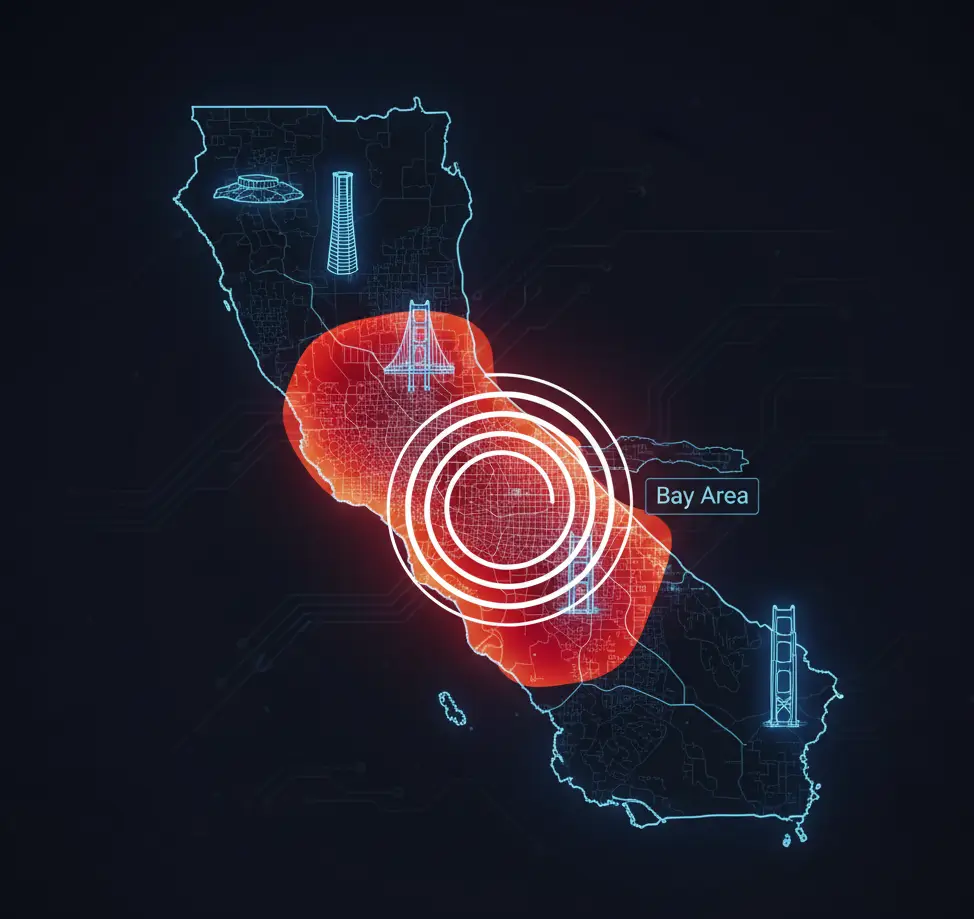On September 22, 2025, a magnitude 4.3 earthquake struck the San Francisco Bay Area shortly after 3 a.m. local time, centered near the UC Berkeley campus in Berkeley, California, along the Hayward Fault. The quake awakened thousands of residents across the East Bay and beyond. Several smaller aftershocks followed, including a notable magnitude 3.0 event later that evening. The quake caused no major injuries or structural damage, but the incident reminded the region of its seismic vulnerability.

Details of the Main Earthquake
Time and Location: The quake hit at approximately 2:56 a.m. PDT, with its epicenter about 1.86 miles southeast of Berkeley, near the UC campus. It occurred at a shallow depth of around 4-5 miles, amplifying the shaking felt in densely populated areas.
Impact:
- Over 30,000 people reported feeling the jolt via the U.S. Geological Survey (USGS) “Did You Feel It?” portal, with sensations described as a sudden, rolling motion that rattled homes, dishes, and windows.
- Minor damage included a broken front window at Magnani’s Poultry store in Berkeley, where staff continued operations despite the disruption.
- The ShakeAlert early warning system, managed by USGS, sent mobile alerts to phones in the area. However, some residents near the epicenter received notifications during or after the shaking began, as seismic waves travel faster than the alert processing time (typically seconds to a minute).
- Transportation disruptions were brief: BART (Bay Area Rapid Transit) trains ran on a short delay for safety inspections but resumed normal service by mid-morning.
Felt Across the Region: People in Oakland, San Francisco, San Jose, and Vallejo felt the shaking. The Modified Mercalli Intensity scale rated it as “moderate” (V) near the epicenter. The quake awakened sleepers and swayed light fixtures but caused no widespread harm.
Aftershocks, Including the 3.0-Magnitude Event
The main quake triggered a series of smaller tremors, which are common as the fault adjusts post-rupture. Key aftershocks included:
- Magnitude 2.3: At 7:44 a.m., about a mile south of the epicenter near Claremont and Ashby avenues—barely noticeable to most.
- Magnitude 2.6: At 8:01 a.m., roughly a mile south, registering as a brief shake for those already on edge from the morning event.
- Magnitude 3.0: The strongest aftershock struck at around 6:20-6:21 p.m. PDT, centered about 12 blocks (or roughly a mile) from the original epicenter, near Claremont and Tunnel Road in Berkeley. This one was felt by over 24,000 people, primarily as a short, sharp jolt, with no reported damage.
After shocks like these are “minor adjustments” along the fault segment that slipped during the initial quake and can persist for days, weeks, or longer. USGS seismologists noted that the relatively low number of aftershocks so far suggests a lower likelihood of escalation.
Seismic Risk and Expert Analysis
The Bay Area sits atop multiple active faults, including the Hayward Fault, which last ruptured significantly in 1868 and is overdue for a major event (estimated 21% chance of a magnitude 6.7+ quake in the next 30 years). This 4.3-magnitude event, while not unusual for the region, prompted updated forecasts from USGS:
Aftershock Probabilities (Next 7 Days):
| Magnitude | Chance of Occurrence |
|---|---|
| 3.0+ | 24% |
| 4.0+ | 3% |
| 5.0+ | <1% |
Foreshock Risk: There’s only a 0.2% chance this sequence foreshadows a larger quake (5.0+) in the coming week, as fewer aftershocks correlate with reduced escalation potential. Seismologist Angie Lux of UC Berkeley described it as a “very typical earthquake for what we would expect in the Bay Area on one of our major faults.”
Experts emphasized that events like this underscore the need for preparedness: secure heavy furniture, maintain emergency kits with water, food, and flashlights, and download apps like MyShake for real-time alerts. “There’s very little warning,” noted one seismologist. “It’s just a whole different ballgame” compared to predictable disasters like hurricanes.
Conclusion
This quake echoes the region’s history, including the 1989 Loma Prieta earthquake (magnitude 6.9), which caused 63 deaths and billions in damage. While Monday’s event was minor by comparison, it jolted residents awake—literally—and reignited discussions on resilience. As of September 23, 2025, no further significant activity has been reported, but monitoring continues via USGS’s real-time earthquake map















